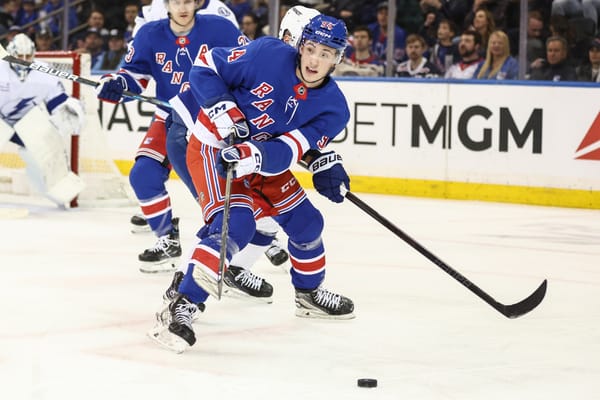Blueshirt Banter 2018 New York Rangers Prospect Rankings: 15-11
15. Tim Gettinger, Left Wing
2017 Ranking: 15
Age: 20
Acquired Via: 2016 Draft (Fifth Round)
If I’m being honest, I was mildly disappointed by Gettinger’s scoring output during his 19-year-old season in the OHL. I thought he would put up 40 goals. Instead, he produced 33 in 66 games after potting 31 in 62 games the season before. Not exactly the end of the world, but given his age and the talent around him I expected a bit more.
Nonetheless, he had a productive season. I can’t say enough about how impressive it is that he not only fit into the Sault Ste. Marie Greyhounds’ system, but was an important player. The Greyhounds play extremely intricate systems and require skill on the puck, good skating, and quick decision making. They’re well known for utilizing undersized players.
So for the 6’6, 220-pound Gettinger to excel within that structure is nothing to shrug off. Gettinger was a zone entry machine. He shows unexpected calm on the puck and will either skate it into the offensive zone or find an open outlet in the neutral zone even under pressure.
It’s also worth noting that he rarely played with SSM’s big guns at five-on-five. At least in my viewings, he was rarely on a line with their top players like Morgan Frost, Boris Katchouk, and Barrett Hayton. Instead, he was usually paired with the good-but-not-great Hayden Verbeek and a more pedestrian third player; often young and (at this time) unproductive 16-year-old Cole MacKay.
Though I’ve established that Gettinger is not just a typical meat-and-potatoes grinder, he does play that role very well. This year he used his size more along the walls. He’s a strong forechecker who uses his size and reach to force turnovers. On the defensive side, he was an elite penalty killer in the OHL and tied for the league lead in 4v5 goals (5).
Theoretically, Gettinger could make the Rangers’ roster or be sent back to the OHL for an overage season. I’d be stunned if he spends 2018-2019 anywhere besides the AHL, however. He would do well to work on his explosiveness because, while his long strides take him far once in motion, it can take a bit for the gears to move. His long reach helps him compensate for that on the backcheck, but going forward it will benefit him at the pro level where the game is a bit quicker.
The upside for Gettinger is perhaps someone like former NHLer Bryan Bickell; someone who can play the role of a physical bottom-six grinder, play important PK minutes, and chip in 15 goals and 30 points.
14. Sean Day, Left Defense
2017 Ranking: 5
Age: 20
Acquired Via: 2016 Draft (Third Round)
While I wouldn’t say anything overly dramatic about Sean Day’s 19-year-old season in the OHL, there was certainly noticeable growth in his game, though a hit to his knee forced him to miss a month. The numbers show this quite clearly, as he produced 47 points in 50 games after earning just 37 in 63 games the season prior.
The main difference for Day was his decision making in the offensive zone. Creating zone entries out of nothing has always been his bread-and-butter, but in the past he struggled to make that final decision that would immediately set his team - if not himself - up for offense. This season, his picked his spots better and used his agility to create space and find passing or shooting lanes.
The aspect that data won’t show (at least directly) is that he cut down on the mistakes. He still plays a high-risk/high-reward style, and the occasional bad decision still happened, but Day showed a lot more understanding of when to try to make a big play happen versus when to slow his roll. He was also a better defender on controlled plays in the defensive zone, cutting down on passing lanes and tying up sticks in the slot.
Day is hardly a finished product, but he’s come a long way from the “all tools, no toolbox” 18-year-old the Rangers drafted in 2016. At this point, any hopes of him becoming a Norris-caliber defenseman are probably a pipe dream, but he still holds second-pairing upside and has the ability to do things that very few defenseman can. Back when he was drafted, a scout I spoke to described his low-end upside as former Ranger John Moore, and that’s looking like fair analysis two years later.
13. Adam Huska, Goaltender
2017 Ranking: 6
Age: 21
Acquired Via: 2015 Draft (Seventh Round)
After a mostly positive freshman season at UConn, Huska had mixed results in his sophomore season. He started the season very slowly, sporting a sub-900 save percentage 10 games in. Though he did have some good individual games, too often he looked out of sorts; not playing with the same confidence he usually exudes in the crease and looking a bit off-tempo at times.
Then he got his game back together and absolutely dominated. He posted a .robust 929 save percentage over his next 14 starts. He gave up more than two goals in just two of those starts, which is particularly notable given that UConn’s defense was nothing to write home about.
However, a wrist injury derailed in mid-January then his season. He would not play again until March, when UConn’s played its final two games of the season against Boston University.
Though on paper Huska dropped seven spots from my rankings last year, it’s mostly meaningless. It speaks to all of the great prospects the Rangers added at the deadline and draft rather than anything that has gone wrong with Huska. He’s still the same quality goaltending prospect with starting potential, and my prediction is that he is one of the top goaltenders in college hockey this upcoming season.
12. Neal Pionk, Right Defense
2017 Ranking: 7
Age: 23
Acquired Via: Free Agent Signing (2017)
Pionk’s first pro season was somewhat strange. Despite scoring a highlight reel goal in the preseason, Pionk was sent to the AHL to start the season. His production in Hartford was modest, as he produced just one goal and 16 assists in 48 games. However, there were some strong signs. He was generating shots and deserved better puck luck. Hartford was also an offensive wasteland, and it was therefore not a great environment for someone like Pionk to rack up assists. As the season progressed his 200-foot game progressed, but he did not exactly look like a player due for a call-up.
But the consequences trading deadline more or less required that the Rangers call him up. Curiously, he managed to play better in the NHL than he ever did with Hartford, generating 14 points in 28 games for a team that was otherwise wounded and dejected. Of the 220 defensemen to play at least 500 minutes in the NHL last season, Pionk ranked 24th in assists-per-60 minutes. Clearly, it’s a small sample with missing context, but objectively speaking he produced a high level of assists in his time in the NHL.
The qualifier here is that his underlying numbers were very poor. He posted a relative Corsi of -6.5%, meaning he got pummeled in the shot attempt battle even in relation to how the rest of the Rangers performed. The same is true for relative expected goals percentage (-7.35%). So while he produced a good number of points, shift-by-shift the ice was tilted in the opposition’s favor with Pionk on the ice.
Of course, even further context is necessary. Pionk was a rookie thrown onto a sinking shift. He was playing in a disastrous Vigneault/Ruff system, and nearly 3/4th’s of his minutes were played with Marc Staal as his defensive partner. That’s an impossible situation for almost any player to succeed in, and his numbers were closer to the realm of passable when he was paired with Brady Skjei.
That is all to say that it’s too soon to reach a verdict on Pionk. He showed a lot of individual ability at the NHL level. For 2018-2019, the Rangers will hopefully deploy him with a competent defensive partner with proper coaching and a suitable tactical setup. By this time next year we should have a very good idea of Pionk’s future, and I could see the answer being a second-pairing, two-way defenseman or out of the NHL altogether.
11. Libor Hajek, Left Defense
2017 Ranking: N/A
Age: 20
Acquired Via: Trade (2018)
Libor Hajek was acquired from the Tampa Bay Lightning in the Ryan McDonagh/JT Miller trade.
With apologies for repurposing the video I used at the time of the trade, Hajek is a great skater who quickly uses that ability to close down on forwards, win puck races, and carry the puck out of the defensive zone to safety.
Where he can run into trouble is on the offensive side of the game. Generating 39 points in 58 games is not that great for a 19-year-old in the WHL. Particularly on a team with a handful of offensive weapons such as the Regina Pats. His skating and decision making will earn him a handful of assists, but there’s not much to speak of in terms of shooting ability, hands, or vision. I’m not sold on his transition ability either, as while he can skate the puck into the neutral zone, he’s not a very good mover of the puck.
There appears to be a gap in the Rangers’ perception of Hajek versus mine. The Rangers reportedly made him a prerequisite for the McDonagh trade to be completed. While I think he’s a perfectly good prospect - I’ve ranked him 11th here, after all - I don’t think he’s that noteworthy.
I’ve spoken to two Western Canadian scouts about Hajek. Partly because I like to make the rounds regardless, but I reach out in particular when there’s a conflict of opinion and I want to check for any blind spots I have. Both scouts noted that Hajek has come a long way since he was drafted, but neither was exactly jumping at the chance to proclaim him a high-caliber defenseman.
I think Hajek will need a year in the AHL to adjust to the speed as well as work on his puck movement. However, there shouldn’t be much of a learning curve for him. He’s a polished, dependable defenseman with good size and strong skating ability. Though Kevin Klein was a different player stylistically, I think he represents a reasonable hope for what kind of impact Hajek could have at the NHL level. A reliable, modest, #4 shutdown defenseman who can hold his own in a more prominent role if his team is in a bind.




